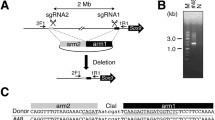Abstract.
Mice that are homozygous for the kidney disease (kd) gene on Chromosome (Chr) 10 spontaneously develop a progressive and fatal interstitial nephritis. The disease phenotype is similar to that of the human disease, juvenile nephronophthisis. Using a backcross and intercross breeding strategy and analysis of over 900 resultant progeny, this genetic locus has now been mapped to a minimal co-segregating region of approximately two megabases between D10Mit 193 and D10Mit 38. The location assigned to kd by this study is over 3 cM from the current Mouse Genome Database location. The entire interval has been cloned in yeast artificial chromosome (YAC) and bacterial artificial chromosome (BAC) clones. Recombinant analysis has permitted assignment of 13 Mit microsatellite markers to positions near or within the region. Two new markers have been identified by using single-strand conformation polymorphism (SSCP) analysis of sequenced BAC ends. Several BAC end sequences align with human BAC clones from Chr 6q21 that contain NR2E1, Snx3, and Ros1. Three murine genes, CD24a, fyn, and ColX reported to map in or near the kd region as defined by this study have been evaluated. Though not definitely excluded, they appear to be unlikely candidates.
Similar content being viewed by others
Author information
Authors and Affiliations
Additional information
Received: 23 July 1999 / Accepted 23 June 2000
Rights and permissions
About this article
Cite this article
MacRae Dell, K., Li, YX., Peng, M. et al. Localization of the mouse kidney disease (kd) gene to a YAC/BAC contig on Chromosome 10. 11, 967–971 (2000). https://doi.org/10.1007/s003350010188
Issue Date:
DOI: https://doi.org/10.1007/s003350010188




